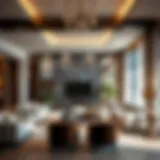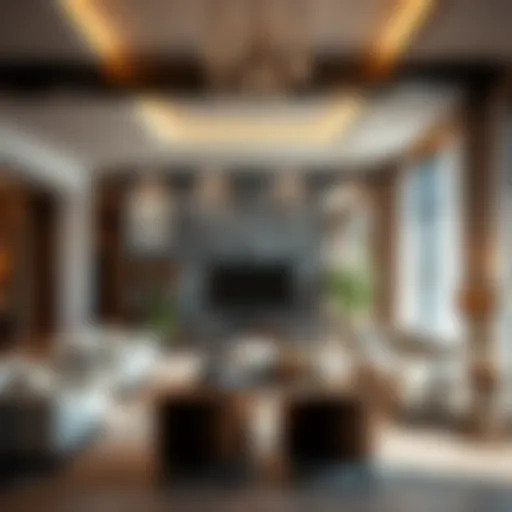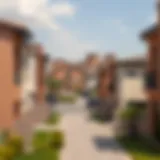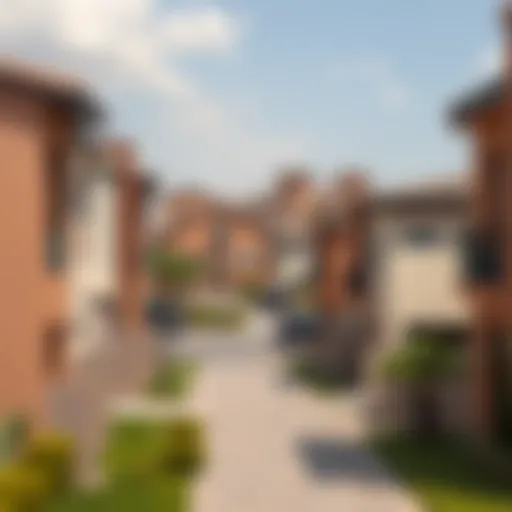Aura Gardens: Transforming Dubai's Real Estate Market
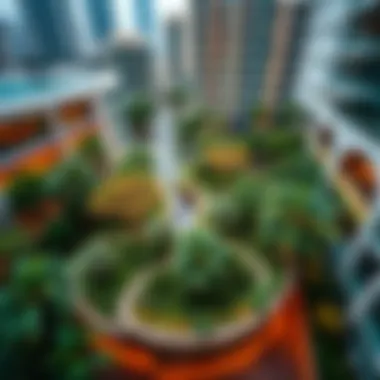

Intro
The concept of aura gardens is becoming a key feature in Dubai's real estate landscape. These green spaces, marked by their unique ability to enhance both property value and quality of life, are sparking conversations among investors, developers, and homebuyers alike. As Dubai continues to expand, the integration of aura gardens not only addresses aesthetic needs but also plays a significant role in urban ecology. In this discussion, we will explore how these gardens are shaping the market dynamics, guiding investment decisions, and contributing to the overall improvement of urban living in one of the fastest-growing cities in the world.
Property Trends in Dubai
Current Market Dynamics
In recent times, Dubai's real estate market has witnessed some wild shifts, driven by a mix of local and international influences. With property prices fluctuating, investors are now looking for value beyond just square footage. The rise of aura gardens has caught their attention; these gardens, often seen as luxurious enhancements, serve not only to beautify but to create serene environments within the bustling city.
Interestingly, the demand for properties with green spaces is on the rise. Buyers are increasingly favoring residences that offer these calming retreats. More than just aesthetics, these gardens contribute positively by impacting air quality and providing habitat for urban wildlife. Who would have thought that a patch of greenery could hold such sway in decision-making?
Emerging Neighborhoods and Areas of Interest
Certain neighborhoods are blossoming in response to this shift. Areas like Dubai Marina and Downtown Dubai are incorporating aura gardens into their master plans.
- Green Community: Known for its commitment to green living, this neighborhood boasts several residential properties that include aura gardens.
- Dubai Creek Harbour: This area is embracing sustainability, with projects focusing heavily on integrating nature into urban settings.
- Al Furjan: This emerging community is building a reputation for family-friendly environments, replete with beautifully designed gardens that invite residents to unwind.
Investors are keenly aware of these shifting landscapes, recognizing the potential for added value in properties featuring aura gardens.
Investment Insights
Key Factors Influencing Real Estate Investments
Investors' choice is often guided by factors such as location, property features, and market trends. Aura gardens are increasingly being seen as a significant feature by potential buyers and investors alike. Here are some pivotal points to consider:
- Sustainability Focus: There's a growing trend towards sustainable and eco-friendly living. Aura gardens help fulfill this desire, making properties more appealing.
- Market Resilience: Properties with aura gardens have shown resilience, even in fluctuating markets. They are perceived as luxuries that can stand the test of time.
- Enhanced Lifestyle: The allure of having a private garden in a high-rise residential setting is a big draw. This lifestyle offering attracts high-net-worth individuals seeking tranquility amidst the urban spread.
Tips for First-Time Investors
For those jumping into the real estate pool for the first time, a few tips can make a world of difference. Here’s some advice:
- Research the Neighborhood: Understanding the area can significantly impact investment decisions. Look at the development plans and the integration of aura gardens in prospective neighborhoods.
- Evaluate Property Features: Don’t just look at the price. Assess the property’s green features, such as gardens and landscape design.
- Think Long-Term: Real estate is not a get-rich-quick scheme. Consider the long-term benefits and how aura gardens could play a role in future property value appreciation.
"Investing in properties featuring aura gardens isn't just about the now; it's about investing in our future from an environmental and lifestyle perspective."
In summary, the integration of aura gardens into Dubai's real estate landscape is a trend that is reshaping market dynamics, attracting interest from both investors and homebuyers. As urban living continues to evolve, these gardens offer a fresh perspective, reminding us that environmental consciousness and quality of life can indeed go hand in hand.
Understanding Aura Gardens
Aura gardens are an emerging phenomenon in urban planning, particularly in places like Dubai, which is known for its rapid development and modernization. Understanding aura gardens involves delving into their definition, characteristics, and the historical context that has shaped their integration into the urban landscape. The proposal to include these green spaces is not just a fad but a calculated move to enhance the quality of living and investing in urban environments.
Definition and Characteristics
Aura gardens represent a blend of natural aesthetics with functionality in urban real estate. Defined simply, they are landscaped areas that incorporate a variety of plants, trees, and water features, designed to create a serene environment amidst the hustle and bustle of city life. Key characteristics include:
- Biodiversity: Unlike traditional gardens, aura gardens focus on native plants, promoting local flora and fauna. This biodiversity not only adds beauty but fosters a balanced ecosystem.
- Sustainability: They are planned with sustainability in mind—implementing water conservation practices and promoting soil health through organic gardening techniques.
- Accessibility: Often designed to be accessible to everyone, these gardens promote inclusivity, encouraging community engagement and interaction.
- Aesthetic Appeal: The incorporation of colorful blooms, aromatic herbs, and calming water features creates a visually pleasing and sensory-rich environment.
Overall, they serve as crucial life spaces that cater to both physical and mental well-being, making them a vital part of urban real estate.
The Historical Context
Understanding the historical context of aura gardens is essential in grasping their relevance today. The concept of integrating greenery within urban settings has ancient roots, with many cultures often establishing gardens to serve as communal spaces, sources of food, and tranquility.
In recent history, the rise of urbanization, particularly in the latter half of the 20th century, led to the neglect of green spaces in favor of concrete developments. However, this trend began to shift in the 21st century as the adverse effects of urban life became evident. Initiatives worldwide have taken shape to restore balance with nature in cities.
In Dubai, the government has recognized the need to foster environments that cater to the well-being of its residents. Historical efforts have included parks and green belts, but the idea of aura gardens has gained traction as a more dynamic alternative. These gardens align with Dubai’s goals for sustainable development, exemplified in projects like Dubai's 2040 Urban Master Plan, which emphasizes the importance of livability and environmental quality as essential elements of urban planning.
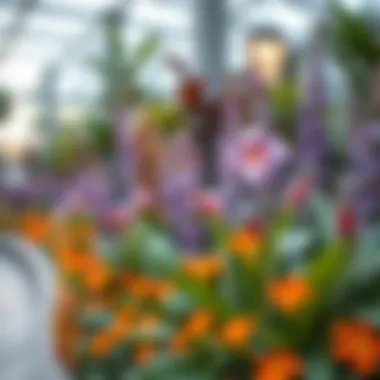

The evolution from traditional parks to aura gardens is not just a trend but a public commitment to enhancing urban ecology, making cities more resilient and enjoyable for residents and visitors alike.
The Importance of Green Spaces in Urban Environments
Green spaces are not just sprigs of greenery stuck in concrete jungles; they are vital lifelines for urban dwellers. The emergence of aura gardens in Dubai's real estate offers an opportunity to reevaluate the role these spaces play within the fabric of city life. The value of incorporating such greenery extends beyond visual aesthetics, impacting health, environmental sustainability, and overall urban quality of life.
Health Benefits of Natural Settings
Natural settings have long been linked to improved mental and physical health. Research indicates that even short exposure to green environments can lead to reduced stress, enhanced mood, and improved cognitive performance. For residents of bustling areas like Dubai, where life's pace is frenetic, the presence of aura gardens can serve as a sanctuary.
- Stress Reduction: Studies suggest proximity to nature can lower cortisol levels, a key stress hormone. This is significant in a high-pressure lifestyle typical in metropolitan settings.
- Physical Health: Greenery encourages residents to engage in outdoor activities like walking, jogging, or yoga. The more green there is, the more inclined people are to spend time outside, fostering a healthier lifestyle.
- Community Connection: Gardens often serve as social catalysts. They provide a communal space where neighbors can gather, share, and build relationships, contributing to overall community well-being.
Consistently, data shows that areas with increased greenery experience lower incidences of anxiety and depression, proving that a connection to nature can be an antidote to the chaos of urban life.
Environmental Impact and Sustainability
Incorporating aura gardens into Dubai’s urban landscape holds significant implications for environmental stewardship. These gardens not only beautify neighborhoods but also contribute to ecological balance.
- Biodiversity Support: Aura gardens can become habitats for various species—be it insects, birds, or small mammals. This fosters a more biodiverse urban ecosystem, which is crucial in maintaining ecological harmony.
- Air Quality Improvement: Plants naturally filter pollutants and produce oxygen. By integrating gardens into real estate projects, developers are practically rolling out the green carpet for cleaner air, impacting public health positively.
- Water Management: Gardens can help in managing stormwater runoff, through techniques like rain gardens or bioswales, contributing to the city’s resilience against flooding.
"Integrating green spaces into urban design is not merely a trend but a necessity for sustainable living in cities like Dubai."
Consequently, the careful planning and execution of aura gardens can elevate the urban environment. They facilitate better air quality, ensure the city can withstand climatic challenges, and enhance the overall sustainability of the metropolis. Not only do these aspects enrich the quality of life, but they also align with global initiatives aimed at promoting environmental responsibility.
Integrating such green spaces within the framework of Dubai’s real estate serves as a springboard for creating a sustainable, health-focused urban environment, setting a high standard for cities worldwide.
Aura Gardens in Dubai
Aura gardens symbolize a distinctive approach within the vast tapestry of Dubai’s real estate. These spaces serve not only as aesthetic enhancers but also as pillars that uplift the living experience in an urban environment. By integrating nature into the dense concrete landscape, aura gardens preserve a slice of greenery while adding significantly to the emotional and social fabric of neighborhoods.
Their significance stretches far beyond mere visuals. Investors and homebuyers alike are increasingly recognizing the emotional recharge that comes from immersing oneself in a peaceful garden setting. Data suggests that properties featuring these gardens tend to command higher prices, as buyers are after more than just walls and roofs; they want a sanctuary amidst the hustle and bustle.
Current Trends in Dubai's Real Estate
Dubai’s real estate market is in a state of evolution. The concept of aura gardens has found its way into various new developments as buyers prioritize wellness and livability. New residential communities are not merely stacking units one atop another—they’re crafting lifestyle environments. Aura gardens are becoming integral to these projects, creating pockets of serenity that invite residents to unwind.
Recent statistics indicate a rise in the number of developers incorporating green spaces into their plans, reflecting shifting consumer priorities. Among these, projects like the Dubai Creek Harbour showcase how merging natural landscapes with modern architecture can form vibrant community hubs. Homebuyers are keen on properties that foster a sense of tranquility and connection to nature. This trend is steering developers towards creating homes where indoor and outdoor environments are fluid.
Regulatory Framework and Guidelines
Building aura gardens is not just a matter of aesthetics; it also requires navigating Dubai’s complex regulatory context. Various laws and guidelines influence how developers approach the incorporation of green spaces. For instance, the Dubai Urban Planning Code emphasizes sustainability and environmental responsibility. Developers must often submit detailed plans showcasing their green initiatives, including how aura gardens will be maintained and woven into existing urban infrastructure.
Key regulations to consider include:
- Land Use Regulations: These dictate where and how green spaces can be developed.
- Environmental Impact Assessments: Required to ensure that new gardens do not adversely affect local ecosystems.
- Building Codes: Must align with safety standards while integrating greenery into high-density designs.
The challenges faced in meeting these guidelines can sometimes be daunting. Yet, a focus on regulatory compliance tends to improve the overall quality and sustainability of the resulting projects. As the framework evolves, so too does the opportunity for developers to lead the way in creating green urban spaces.
Economic Implications of Aura Gardens
Aura gardens, often seen as mere aesthetic embellishments, have deeper economic implications that can transform Dubai's real estate landscape. From the perspective of investors and property developers, these green spaces offer an avenue for enhancing property market value and tapping into shifting consumer preferences. The integration of nature into urban environments serves a dual purpose: it not only beautifies a space but also contributes to the financial vitality of properties. As the notion of sustainability gains traction, understanding the economic aspects of aura gardens becomes vital for strategic planning in the real estate sector.
Value Addition to Properties
The incorporation of aura gardens into residential and commercial properties generally translates into increased property value. Buyers are becoming more selective about their investments. A property boasting a well-designed aura garden can stand out in a bustling market like Dubai's. Many studies show that homes surrounded by green spaces tend to sell for more than comparable properties without such features. This increase isn’t just a minor bump; it can account for a substantial percentage of the property’s overall valuation.
Key Factors Influencing Value
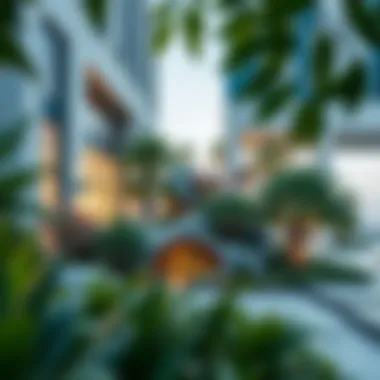

- Aesthetic Appeal: A well-maintained aura garden enhances the visual representation of a property, contributing to first impressions that can seal the deal.
- Market Differentiation: In competitive markets, having a unique feature like an aura garden can make a property more desirable.
- Psychological Appeal: Buyers often associate greenery with tranquility and a good quality of life, influencing their decision to invest.
Indeed, investing in well-conceived aura gardens not only enriches the community aesthetically but also creates lasting economic benefits. The return on investment for developers who prioritize green spaces is usually promising, especially in an era where environmentally friendly developments are gaining strength.
Market Demand and Consumer Preferences
Understanding market demand linked to aura gardens reveals significant insights into modern consumer behavior. Today's buyers are increasingly prioritizing sustainability and wellness. They are not just looking for a roof over their heads; they want a lifestyle that resonates with their values. The following trends illustrate this shift:
- Increase in Demand for Sustainable Living: Properties with aura gardens attract eco-conscious buyers who appreciate efforts toward environmental sustainability.
- Health and Wellness Trends: Gardens promote mental and physical well-being. As urban stress accelerates, consumers lean towards homes that offer relaxation spaces.
- Family-Friendly Environments: Buyers with children often prefer homes that provide safe outdoor spaces for them to play and connect with nature.
In summary, it's clear that the integration of aura gardens offers substantial economic advantages not just to individual properties but to the parent real estate market in Dubai. As the demand for eco-friendly and health-conscious living spaces rises, developers and investors must take heed of consumer preferences, aligning their projects with the vibrant potential of aura gardens. This ensures that investments are both profitable and forward-thinking.
"In the battle for buyer attention, aura gardens emerge not just as a trend but as a strategic necessity for modern developments."
Designing Effective Aura Gardens
Designing effective aura gardens is about more than just planting a few flowers and calling it a day. In the context of Dubai's urban landscape, where space can often be a premium, these gardens represent a convergence of aesthetics, functionality, and sustainability. They provide a glimpse into how urban planners can incorporate green spaces that not only enhance property values but also boost the quality of life for residents. The design process must consider local climate conditions, materials that reflect cultural values, and the needs of the community. This ensures the garden serves a purpose beyond mere decoration.
Essential Design Principles
When embarking on the journey of creating aura gardens in an urban environment like Dubai, one must follow some key principles of design:
- Contextual Relevance: Understanding the unique characteristics of the site is paramount. This means analyzing the local climate, soil types, and existing flora. For instance, drought-resistant plants should be prioritized to thrive in Dubai's arid conditions.
- Functionality: Aura gardens should cater to various activities. Whether it’s a place for families to gather, kids to play, or individuals to relax, functionality matters. Zoning areas within the garden can create diverse spaces that fulfill different needs.
- Biodiversity: Promoting a variety of plant species enhances ecological stability. Diverse plant life not only provides visual interest but also supports local wildlife, contributing to a thriving ecosystem.
- Sustainable Practices: Designing with sustainability in mind includes using native plants, efficient irrigation systems, and recycled materials for pathways or structures. It ensures that the garden has minimal environmental impact and promotes resource conservation.
- Cultural Integration: Considering local heritage is crucial. Incorporating elements that reflect Dubai's history and culture—like traditional landscaping styles or local art—can create a sense of belonging and pride among residents.
Integrating Technology and Nature
As we move further into the digital age, the integration of technology with nature in aura garden design becomes increasingly beneficial. The smart use of tech can enhance residents’ experience while also aiding maintenance efforts. For instance:
- Smart Irrigation Systems: These systems automatically adjust water usage based on real-time weather data, ensuring plants are optimally hydrated while conserving water resources.
- Monitoring Sensors: Sensors can gauge soil moisture, temperature, and even light levels, allowing for precise adjustments that keep the garden healthy without unnecessary waste.
- Augmented Reality: Future developments might even integrate AR offerings where residents can use their smartphones or tablets to explore plant information, learn about the ecosystem in their garden, or engage in community events.
The success of aura gardens in Dubai will largely depend on a balanced marriage between technology and the natural environment, creating spaces that are not only beautiful but also functional.
The integration of such technologies must, of course, be done with care. The aim is not to overshadow the natural beauty of the gardens, but rather to enhance the experience. Potential buyers and developers would do well to consider how smart technologies can add value, making the gardens more appealing in the competitive Dubai real estate market.
In summary, a well-designed aura garden is a multifaceted space that harmoniously blends the natural environment with innovative aspects of modern living. Such gardens can elevate not just individual properties but the entire community, contributing to a healthier, more sustainable urban ecosystem.
Challenges in Implementing Aura Gardens
The inclusion of aura gardens in Dubai's real estate landscape presents a unique set of challenges that require careful navigation. Understanding these issues is critical for developers and investors alike, as they inform both the feasibility and sustainability of such projects. Addressing these challenges not only enhances the aesthetic appeal of properties but also contributes significantly to the urban ecosystem. Let’s examine these elements in depth.
Space Constraints in Urban Settings
In a bustling metropolis like Dubai, land is at a premium and suitable spaces for aura gardens often hard to come by. Developers face an uphill battle when trying to carve out room for green spaces since the efficient use of land is pivotal for maximizing residential or commercial potential. This limitation can be attributed to a variety of factors:
- High Demand for Urban Real Estate: Given the rapid expansion of the city, many areas are densely populated, leaving little breathing room for significant landscaping projects.
- Zoning Regulations: Stricter laws regarding land usage often inhibit the planned integration of aura gardens, as compliance with existing building codes and ordinances can be a daunting task.
- Economic Considerations: The economic return on investment for large land areas dedicated solely to gardens may discourage developers from pursuing these initiatives.
To mitigate these space constraints, some developers have turned to vertical gardens or rooftop green spaces, solutions that allow them to maximize their property’s footprint while still providing the much-needed greenery. Adaptable designs that incorporate nature into existing structures could be the way forward, however, not every developer is on board yet.
Maintenance and Management Issues
After overcoming the hurdle of initial installation, the ongoing maintenance of aura gardens presents its own set of complications. Property managers frequently grapple with the practicalities of preserving these spaces while ensuring they meet residents' expectations. Key aspects include:
- Expertise Required: Proper maintenance of distinctive flora and fauna requires trained personnel who understand the unique demands these ecosystems present. Incorrect methodologies can lead to the deterioration of these spaces.
- Cost Implications: Resources allocated for upkeep must be factored into budget planning. A lush garden may attract residents and increase property values, but it also comes with increased operational costs.
- Weather Vulnerabilities: Climate in Dubai can be unforgiving. Gardens need to be designed with this in mind, yet many projects overlook specific vegetation types that are drought-resistant or suited to intense heat.
"The road to sustainability is paved with challenges, but each obstacle presents an opportunity for creativity and growth."
For more insights on urban planning and environmental integration, refer to resources such as Wikipedia and Britannica for historical contexts and contemporary practices in city landscaping.
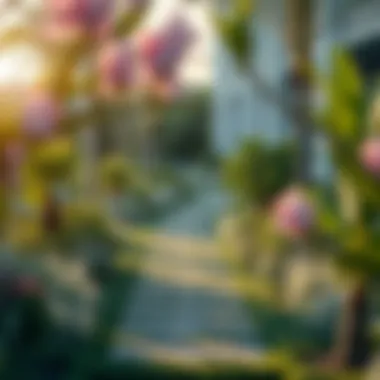

Case Studies of Successful Aura Gardens
Examining local and international case studies is crucial for understanding the practical applications of aura gardens within real estate developments. These examples illustrate how integrating green spaces enhances property value, increases attractiveness to buyers, and contributes positively to urban ecosystems. The nuances of each project reveal various strategies and innovations that can be adopted in future developments in Dubai and beyond.
Local Projects in Dubai
Dubai is a city where the skyscrapers and urban sprawl often overshadow green spaces. Yet, several projects have emerged showcasing the integration of aura gardens. One notable example is The Sustainable City. This community focuses on sustainability and features lush greenery, solar-powered homes, and dedicated areas for flora. The aura gardens in this development aren’t merely aesthetic; they also serve practical purposes, such as improving air quality. Residents here have reported an increased sense of community and overall well-being.
Moreover, the Dubai Creek Harbour project showcases an innovative approach to incorporating gardens within high-density residential structures. Here, the developers prioritized green roofs and vertical gardens, which provide residents with easy access to nature, a rarity in urban Dubai. Such projects demonstrate that with thoughtful planning, even limited spaces can blossom into vibrant green areas that enhance living conditions and add value to properties.
"The presence of green spaces significantly improves the quality of life, making urban living less taxing and more inviting."
This emphasis on local flora and fauna not only beautifies the landscape but also promotes biodiversity. Such projects highlight how urban developments can align with ecological goals, ensuring that economic growth does not sideline nature.
International Examples Worth Considering
Looking beyond the borders of Dubai, cities worldwide have implemented successful aura garden projects that serve as effective blueprints for future endeavors. For instance, Singapore has earned accolades for its commitment to integrating greenery into urban planning. The Gardens by the Bay is a renowned example where nature and modern architecture coexist harmoniously. This project has attracted millions of visitors and directly contributed to an increase in local property values by elevating the surrounding area's appeal.
In Europe, Milan's Bosco Verticale is another remarkable initiative. This vertical forest consists of two residential towers adorned with thousands of trees and shrubs. The developers ingeniously transformed the idea of an aura garden from a horizontal layout to a vertical one, addressing space constraints in an innovative way. The impact on residents’ mental health and quality of life has been substantial—providing a serene escape from the bustling city below.
These international examples not only validate the concept of aura gardens but also provide insights into innovative design approaches, such as vertical gardening and multi-use spaces. Each successful project reinforces the potential benefits of integrating natural elements within urban environments, offering valuable lessons for Dubai as it continues to evolve its real estate landscape.
Future Directions for Aura Gardens in Dubai
Looking ahead, the integration of aura gardens in Dubai's real estate landscape appears to offer a promising path that resonates well with the growing community interest in sustainability and quality of life. These gardens have the potential not only to beautify urban spaces but also to reshape how individuals interact with their environments. As we delve into this topic, it becomes apparent that the future of aura gardens hinges on various elements that could influence their adoption and effectiveness.
The importance of understanding the directions in which aura gardens will evolve cannot be overstated. Whether you are a developer, investor, or homebuyer, being aware of the trends and developments surrounding these green spaces will facilitate better decision-making in a market that is rapidly adapting to changing environmental and social demands. Aura gardens are not merely aesthetic enhancements; they represent a shift towards more holistic urban living, marrying nature with modern architecture and lifestyle.
Predicted Trends and Developments
In the coming years, several trends are expected to take root in Dubai's approach to aura gardens. One significant trend that’s gathering steam is the focus on sustainability. As the UAE commits to ambitious sustainability goals, developments will increasingly feature flora that requires less water and maintenance. This aligns well with Dubai's climate and promotes a deeper commitment to environmental conservation.
- Vertical gardens: The push towards vertical gardening, particularly in high-rise developments, signifies a creative way to integrate greenery without needing excessive land.
- Native plant integration: Building with local flora that thrive in arid conditions can minimize water usage and support local ecosystems.
- Smart technology: Homeowners want better control of their spaces; hence the incorporation of smart irrigation systems could become a common sight in aura gardens. This innovation will not only conserve water but also optimize maintenance tasks for property managers.
"Sustainable cities of the future depend on how well we integrate nature into urban environments."
These predicted developments illustrate a broader trend that addresses both ecological needs and aesthetic desires, creating a win-win scenario for urban developers and inhabitants alike.
Role of Stakeholders in Promoting Green Initiatives
Integral to the successful implementation of aura gardens in Dubai's real estate is the involvement of various stakeholders. Developers, property managers, government bodies, and residents all have key roles to play.
- Developers need to prioritize green spaces in their blueprints, recognizing that integrating such features directly correlates with property values and buyer appeal.
- Local governments can help by providing guidelines that incentivize the establishment of aura gardens, making it easier for projects to receive approval when they include these green spaces.
- Residents can voice their opinions and preferences, encouraging community-focused designs that prioritize the well-being of inhabitants over purely commercial interests.
This collaborative approach not only fosters more vibrant communities but also cultivates a shared responsibility towards environmental stewardship, ultimately leading to an enhanced quality of life in urban settings like Dubai.
Ending: The Role of Aura Gardens in Shaping Dubai’s Urban Future
As we draw the curtain on this exploration of aura gardens, it becomes apparent how pivotal they are in redefining the urban fabric of Dubai. These green spaces are not just patches of greenery amid skyscrapers; they are integral to creating a balanced environment that harmonizes nature with urbanity.
The significance of integrating aura gardens in urban settings echoes through multiple dimensions. First and foremost, they serve as vital lungs for the city, offering residents and visitors alike a refuge from the bustling streets. In a metropolis that thrives on ambition and luxury, the presence of nature becomes a symbol of a more sustainable and health-conscious approach to urban living.
Additionally, aura gardens enhance property values significantly. Investors, in particular, find that properties integrated with lush, well-designed gardens are more attractive to potential buyers. This added value stems not only from the aesthetic appeal but also from the perceived quality of life enhancements that accompany such spaces.
Furthermore, these gardens provide psychological benefits too. Green environments have been shown to reduce stress and improve mental well-being—a notion that is increasingly important as more people navigate the fast-paced lifestyle that Dubai demands. By weaving these natural elements into the city’s DNA, Dubai not only responds to the current demands of its citizens but also prepares for a sustainable future.
"In essence, aura gardens offer a bridge between humans and nature, becoming essential components of urban planning strategies."
Summarizing Key Insights
The journey through the role of aura gardens is more than just a passing trend; it indicates a shift towards a better balance in urban development. Here are some key takeaways:
- Health Benefits: Aura gardens contribute to improved mental and physical well-being through exposure to natural elements.
- Property Value Enhancement: Properties featuring aura gardens are more appealing in the real estate market, leading to higher demand and value.
- Sustainability: These gardens promote biodiversity and environmental sustainability, both of which are essential for the long-term viability of urban landscapes.
- Aesthetic Appeal: They provide a visual respite and create a sense of place within densely populated urban settings.
By fostering a collaborative approach among all parties involved, the vision of a greener, more livable Dubai becomes attainable. The road ahead may hold challenges, but with informed strategies, the potential for aura gardens to shape the urban future of Dubai is undeniably promising.




